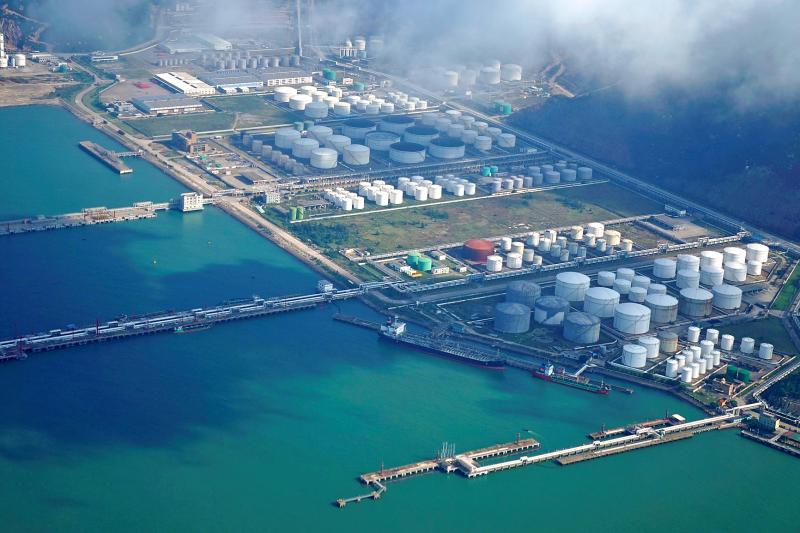The International Energy Agency (IEA) on Tuesday trimmed its global oil demand forecast for this year as fresh COVID-19 lockdowns cloud the outlook, but said that mass vaccination programs should help bolster a second-half rebound.
“Global oil demand is expected to recover by 5.5 mb/d [million barrels per day] to 96.6 mb/d in 2021, following an unprecedented collapse of 8.8 mb/d in 2020,” the IEA said in its latest monthly report.
“For now, a resurgence in COVID-19 cases is slowing the rebound, but a widespread vaccination effort and an acceleration in economic activity is expected to spur stronger growth in the second half of the year,” it said.

Photo: Reuters
“This recovery mainly reflects the impact of fiscal and monetary support packages, as well as the effectiveness of steps to resolve the pandemic,” it added.
The IEA said that it now expected demand in the first quarter of this year to be 0.6 million barrels per day less than previously forecast, with the full-year outcome revised down by 0.3 million barrels per day.
On the supply side, the IEA said that after “falling by a record 6.6 mb/d in 2020, world oil supply is set to rise by over 1.0 mb/d this year.”
“There may be scope for higher growth given our expectations for further improvement in demand,” the IEA added.
It said that its forecasts assume that in the second half of this year, OPEC+ — OPEC members plus non-cartel producers, principally Russia — would continue to rein in output, withholding 5.8 million barrels per day of oil from the market in line with their agreement in April last year.
The IEA said that OPEC+ has recently adopted a more flexible stance and would be meeting regularly to assess output levels.
Oil prices have risen in recent weeks on hopes the global economy would get back on track later this year.
The IEA said these higher prices could “provide an incentive to increase production by the US shale industry, which saw the biggest fall in output last year.”
However, shale producers appear set to stick with promises to keep output largely flat so as not to jeopardize prices.
“If they stick to those plans, OPEC+ may start to reclaim the market share it has steadily lost to the US and others since 2016,” the IEA said.

Among the rows of vibrators, rubber torsos and leather harnesses at a Chinese sex toys exhibition in Shanghai this weekend, the beginnings of an artificial intelligence (AI)-driven shift in the industry quietly pulsed. China manufactures about 70 percent of the world’s sex toys, most of it the “hardware” on display at the fair — whether that be technicolor tentacled dildos or hyper-realistic personalized silicone dolls. Yet smart toys have been rising in popularity for some time. Many major European and US brands already offer tech-enhanced products that can enable long-distance love, monitor well-being and even bring people one step closer to

Malaysia’s leader yesterday announced plans to build a massive semiconductor design park, aiming to boost the Southeast Asian nation’s role in the global chip industry. A prominent player in the semiconductor industry for decades, Malaysia accounts for an estimated 13 percent of global back-end manufacturing, according to German tech giant Bosch. Now it wants to go beyond production and emerge as a chip design powerhouse too, Malaysian Prime Minister Anwar Ibrahim said. “I am pleased to announce the largest IC (integrated circuit) Design Park in Southeast Asia, that will house world-class anchor tenants and collaborate with global companies such as Arm [Holdings PLC],”

Thousands of parents in Singapore are furious after a Cordlife Group Ltd (康盛人生集團), a major operator of cord blood banks in Asia, irreparably damaged their children’s samples through improper handling, with some now pursuing legal action. The ongoing case, one of the worst to hit the largely untested industry, has renewed concerns over companies marketing themselves to anxious parents with mostly unproven assurances. This has implications across the region, given Cordlife’s operations in Hong Kong, Macau, Indonesia, the Philippines and India. The parents paid for years to have their infants’ cord blood stored, with the understanding that the stem cells they contained

Sales in the retail, and food and beverage sectors last month continued to rise, increasing 0.7 percent and 13.6 percent respectively from a year earlier, setting record highs for the month of March, the Ministry of Economic Affairs said yesterday. Sales in the wholesale sector also grew last month by 4.6 annually, mainly due to the business opportunities for emerging applications related to artificial intelligence (AI) and high-performance computing technologies, the ministry said in a report. The ministry forecast that retail, and food and beverage sales this month would retain their growth momentum as the former would benefit from Tomb Sweeping Day